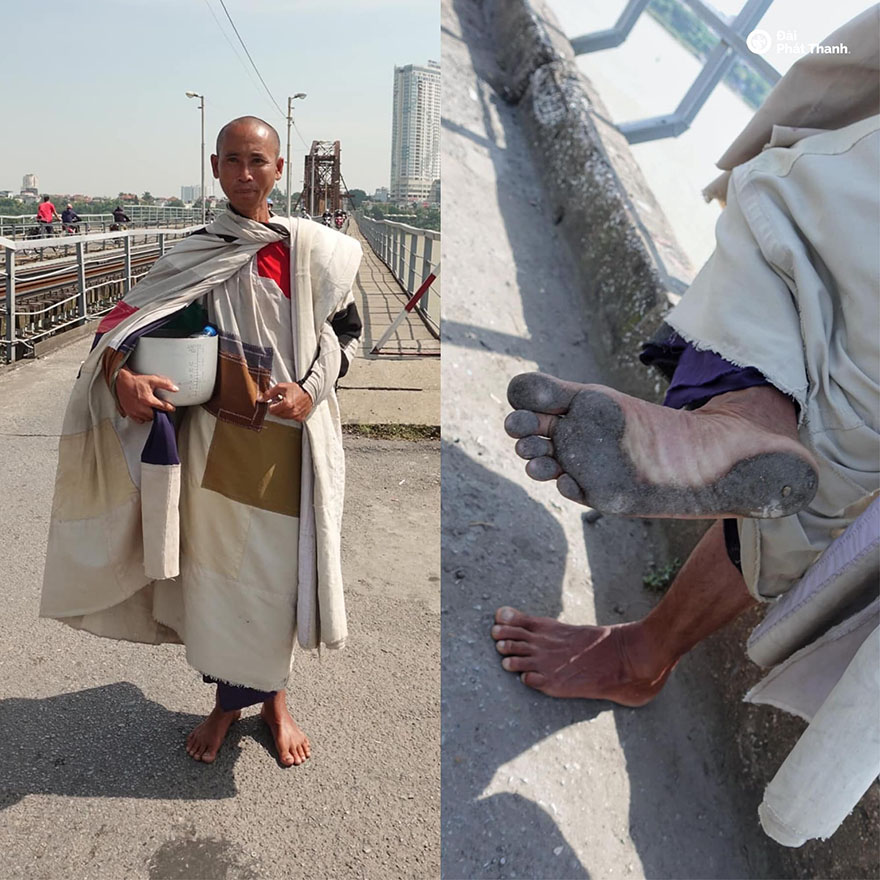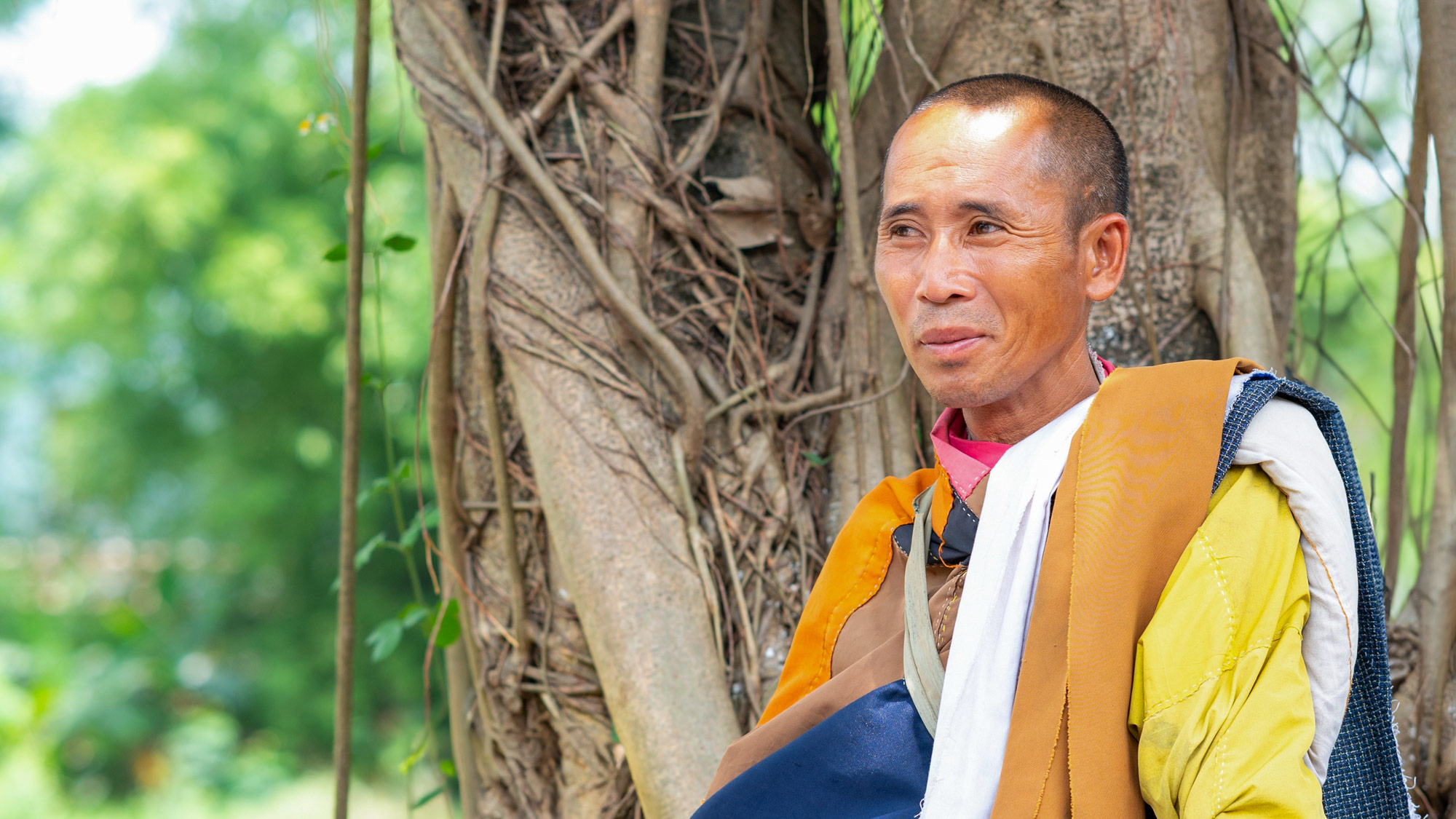Thich Minh Tue was an obscure ascetic who believed he’d left the material world behind, but the world was not done with him. Thanks to TikTok, Facebook, and other social media platforms, Minh Tue was catapulted into the spotlight in the spring of 2024 and became the talk of Vietnam.
Heated debates erupted online: Was he really a monk? Did it matter if he was a monk, given his steadfast commitment to his spiritual path? Why venerate him? In comparison to the state-sanctioned, allegedly-corrupt monks who live in opulence in ornate temples, why not venerate him? These questions swirling around Thich Minh Tue are at the heart of what Vietnamese society is grappling with today, secularly and spiritually.
Minh Tue was born in 1981 in Ha Tinh province in Central Vietnam. His birth name was Le Anh Tue, and he was the second child in a family of four children. After finishing high school, he completed his three-year military service. Then he studied forestry and worked as a land surveyor. In 2015, he renounced the material world, becoming a monk and taking the dharma name Minh Tue. Soon, though, he left the monastery, carrying nothing but a rice cooker for gathering alms. He walked barefoot for years on scorching asphalt, the soles of his feet turning charcoal black.

When Minh Tue’s fame grew, so did the crowd that followed him. Some young men shaved their heads, wore Buddhist robes, and took up alms-seeking in his footsteps, while others meticulously documented his every movement online. Minh Tue tried to dissuade them—he wanted to be left alone to walk his spiritual path—but to no avail. His increasing visibility made him a target of state authorities.
While the Unified Buddhist Sangha of Vietnam—banned by the government but operating overseas with global influence—recognizes Minh Tue and praises him as possessing the virtues befitting a Buddhist monk, the state-sanctioned Vietnam Buddhist Sangha does not. One of its monks, Thich Chan Quang, head of the Chan Quang Pagoda and of the finance committee for a state-backed Buddhist organization, denounced Thich Minh Tue in a sermon posted online, calling him a “thug who wears ragged attire and holds a rice cooker.” The backlash was so intense that Quang’s sermon was taken offline.
Thich Minh Tue’s growing influence came at a time when Vietnam’s materialistic aspirations were facing deep scrutiny. Technically a communist nation, Vietnam allowed private capitalism after the Cold War, and over three decades later, money-making has become the new ideology. Billboards, electronic ads, and commercials flood the senses, hawking beer, cars, condos, and the latest gadgets. Even hotel elevators bombard visitors with digital screens urging them to invest in real estate, buy designer furniture, or dine at Michelin-recognized restaurants. And why not consider cosmetic surgery for a new nose or eyelids to look like a Korean pop star? In a way, Vietnam has become a thriving market writ large.
Yet, amid the towering billboards, luxury high-rises, and nonstop consumer advertising, spiritual yearning hasn’t disappeared. If anything, the public fascination with Minh Tue suggests an underlying discontent—a longing for something beyond material wealth. Materialism, after all, does not give a country a sense of direction. And recent financial scandals, such as the conviction of real estate tycoon Truong My Lan for orchestrating Vietnam’s largest-ever banking fraud, have only deepened public cynicism about unchecked greed and corruption.
But if Lan was dangerous to the ruling elite because her corruption exposed the underbelly of a money-obsessed nation—implicating high-ranking Communist Party members along the way—Minh Tue and his followers pose a different kind of threat. They reveal a collective hunger for the return of spirituality, a national purpose beyond wealth accumulation.
This is not the first time Vietnam has been stirred by a Buddhist leader whose presence challenged the ruling establishment. Thich Nhat Hanh, the world-renowned Zen master, faced a similar fate decades earlier. In the 1960s, he worked to modernize and unify Vietnamese Buddhism, founding Van Hanh Buddhist University in Saigon, which offered courses in Buddhist studies and Vietnamese culture. But when he traveled abroad to advocate for peace during the Vietnam War, the South Vietnamese government accused him of being an antiwar activist and barred him from returning. Forced into exile, he went on to teach Zen globally, penning over 130 books and becoming one of the most influential Buddhist teachers of modern times. Vietnam’s loss became the world’s gain.
Decades later, when Thich Nhat Hanh was finally allowed to return to his homeland, it was only under strict supervision. After suffering a massive stroke, he returned one last time to spend his final years in his native city of Hue. His teachings on mindfulness, compassion, and the middle path remain deeply relevant in Vietnam today, where figures like Thich Minh Tue embody the struggle between materialism and spirituality.
Thich Minh Tue’s story also evokes the memory of another Vietnamese monk who made history through an act of radical self-sacrifice. In 1963, Thich Quang Duc, a senior monk, shocked the world when he set himself on fire at a busy Saigon intersection in protest against the persecution of Buddhists by the South Vietnamese government. (The term “self-immolation” entered the English lexicon after his fiery protest.) His image, captured in a now-iconic photograph, became a searing testament to the power of spiritual resistance. While Minh Tue’s path is one of silent wandering rather than dramatic protest, both monks serve as reminders that Buddhism in Vietnam has long been intertwined with struggles for justice and moral integrity.
Minh Tue’s journey has continued to meet resistance. One night in April 2024, as he and his followers rested in an open-air camp, police raided the site. Soon after, he appeared on national television, stating that he would end his pilgrimage due to the social disturbances it caused. He announced his intention to return to his family home, yet was later seen wandering through nearby neighborhoods before disappearing altogether in July.
Then, at the tail-end of 2024, the ascetic reemerged—this time with an even more astonishing goal. According to recent reports, he and a small group of followers are walking from Vietnam to India, the Buddha’s birthplace. As of this writing, he has crossed Laos, is making his way through Thailand into Myanmar and beyond. His journey, however, is not without controversy, as one of his travel companions is a government-hired handler, monitoring his movements and public statements while restricting certain questions from local press.
In Vietnam, the stories of Thich Minh Tue and Thich Nhat Hanh, though separated by time, echo each other in profound ways. Both monks embody the spiritual hunger of a nation caught between material ambition and deeper existential questions. If wealth has become the dominant ideology in Vietnam, it has also left many searching for meaning beyond its trappings. Thich Minh Tue’s barefoot journey and Thich Nhat Hanh’s lifelong teachings both point to a deeper truth: that the spiritual path, though often obstructed, remains vital.
A beloved Vietnamese folk song about the lotus flower, often sung by rural children, captures this tension:
In the pond, nothing is more beautiful than the lotus
Green leaves, white flowers, and yellow pistils
Yellow pistils, white flowers, green leaves
Close to the mud but not tainted by the smell of mud
No wonder, then, that in Buddhism, the lotus—on which the Buddha sits—is such a potent and complex symbol. As Thich Nhat Hanh often said: “No mud, no lotus.” Without the mud’s sustenance, the lotus could not grow. Yet without rising above the mud and opening fully to the sunlight, it could never truly bloom.
The Buddha once spoke of the middle path, having realized—after nearly starving himself in his search for enlightenment—that neither extreme asceticism nor indulgence would lead to liberation. Only after accepting an offering of milk rice did he regain the strength to continue his journey.
Perhaps for many, the middle path means holding two truths: Sustaining oneself is a necessity, but not being consumed by greed and illusion is also a necessity. Despite life’s struggles and distractions, the challenge is to walk one’s spiritual path while always aiming, like the lotus, toward the light.
